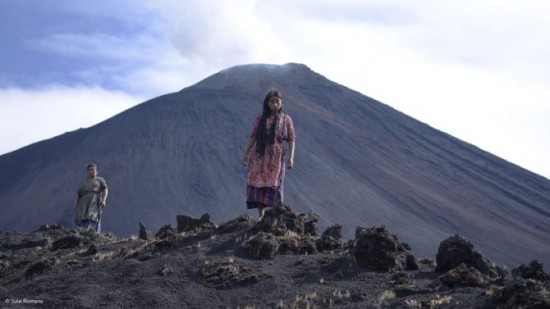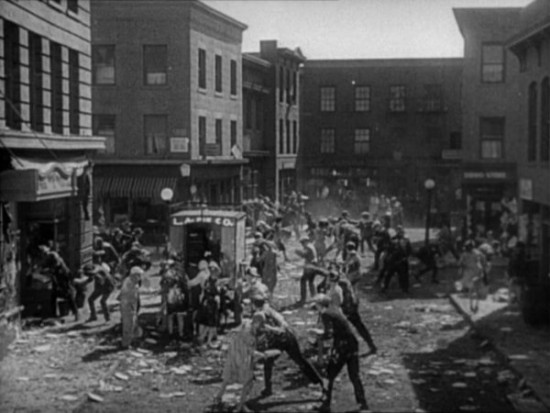Notes from the Telluride Film Festival
Post by Mary Beth Haralovich, University of Arizona
A film festival is an individual experience. For Tucsonans, the Telluride Film Festival begins with a long day’s drive from 2,500 feet to 10,000 feet elevation through canyons, chaparral, forest, wildflowers, rock formations, up into the San Juan Mountains. Once in town, in rain-sun-snow, we walk among the nine screening venues, seminars in the park, conversations in the courthouse, and a Vimeo suite playing found footage documentaries by Adam Curtis, a 2015 Silver Medallion awardee.
The Telluride fest is put on by a staff of more than 800, mostly volunteers. Only a few venues exist as fixed seat theaters. A school gymnasium is converted into a state-of-the-art screening venue with comfortable raked seats, 35mm, 70mm and even 3D capability. The Werner Herzog with its 650 ruby red seats and curtained walls is an ice hockey rink. One of the smaller houses, Le Pierre, is a climbing gym now decorated with huge images of old 35mm film cans celebrating long-time Telluride fest curator Pierre Rissient. The Chuck Jones evokes his Martian cartoons. The Galaxy décor is a trip to the moon and beyond. The ingenuity of Telluride’s venues never fails to astound.
Telluride is a welcoming and friendly festival. And there are always surprises. During the intermission between the two parts of Die Niebelungen (Fritz Lang, 1924, 275 minutes plus intermission)–Siegfried and Kreimheld’s Revenge–the fest offered filmgoers complimentary beer and brats, freshly grilled on the patio outside the Herzog. Before the screening of the restored art deco L’inhumaine (Marcel L’Herbier, 1924), curator Serge Bromberg took a photo of the audience to send to the daughter of the woman who played the peasant. The daughter was born nine months after the film was made. The Alloy Orchestra performed its original score live, voicing chanteuse Claire Lescot (Georgette Leblanc) with the delicate treble of a hand saw.
This inventive environment is casual and easy-going. Telluride is not a market and there are no paparazzi. Films and filmmakers are not ballyhooed in advance or at the fest. There are Telluride regulars–Alexander Payne, Werner Herzog, Ken Burns, Peter Sellars, Serge Bromberg, Laura Linney, Pierre Rissient–and well-known film creatives with new releases. This year, one could run into Idris Elba, Meryl Streep, Tom Noonan, Rooney Mara, Danny Boyle, and more.
There are several types of passes. Some include the opening night feed on the main street and the Labor Day picnic in the park. The food is tasty and there are vegan and vegetarian options. It is possible to have a great fest without a pass, as there are free screenings (passholders usually have priority), outdoor screenings at the Abel Gance, book and poster signings, and open seminars. I get the curated Cinephile pass with access to Telluride’s impressive film history dimension as well as independent and foreign films. On Labor Day, after the picnic, the Cinephile passholder has access to the more mainstream films.
My Cinephile pass will color this report. The only new release-with-stars that I saw was Carol, Todd Haynes’ splendid 1950s lesbian drama. The film evoked not only the look of the 1950s (somewhere I have the bracelet that Cate Blanchett is wearing!) with nods to Ross Hunter-Douglas Sirk melodrama, but also the feel of 1950s lesbian fiction. It is a great pleasure to see a luscious mainstream film with the gold standard projection and screening space that is a hallmark of the Telluride Film Fest. We might have seen Steve Jobs (Danny Boyle), but chose instead to experience curator/archivist Paolo Cherchi Usai’s experimental pilgrimage, Picture (2015, 68 minutes) with its two pages of film theory as an introduction and live performance by Alloy Orchestra.
Our three favorite current films were Taxi from Iran, Ixcanul from Guatemala, and Siti from Indonesia. Taxi (Jafar Panahi) was the film most often screened at the fest. In his inspired and inspiring introduction, festival director Peter Sellars situated Taxi at the cusp of freedom and restriction. Panahi is under house arrest and forbidden from making films for 20 years, yet he made Taxi. Panahi could not travel to Berlin to receive the Golden Bear yet the government congratulated him on the award. Taxi is experimental documentary, political commentary, and joyous comic encounters.
The dramatic and realist story in Ixcanul (Jayra Bustamente) is based on the life of the actress playing Maria in the film. The Mayan peasant lifestyle on a coffee plantation on the side of a volcano is so beautifully realized that audiences were astounded to learn that Maria’s father is played by a dentist. Maria’s mother, the heart of the film, is a woman of incredible mental, emotional, physical, and intellectual strength. She is played by a Mayan peasant who joined an acting troupe after she became widowed. This film held us in rapt attention. Later, we learned the production story behind the film.
Festival director Pierre Rissient brought Siti (Eddie Cayhono) and the short Cinema (Eric Khoo, Singapore). Cinema tells the story of a low-budget horror film production decades later as the now elderly crew gathers in a sound stage. Siti is a film about a young single mother, working in a karaoke to raise funds to pay off the debt of her invalid husband. The film weaves throughout a subtle motif of the sea.
One consistent characteristic of the Telluride fest is the opportunity to see films that are rarely screened and otherwise not available. This year’s guest director, novelist Rachel Kushner, brought rarely seen films by Jean Eustache (France), Ted Kotcheff (Australia), Robert Frank (Switzerland), Francesco Rosi (Italy), and a program with short films by Jean Renoir, Agnès Varda, and Jean-Luc Godard.
There was a strong political cinema strand. Participant Media received the annual Special Medallion that “celebrates a hero of cinema” and Adam Curtis received a Silver Medallion tribute. Curtis makes docs culled from archival footage shot by BBC journalists. From terabytes of footage covering Afghanistan, Bitter Lake (2015) traces the rise of ISIS from its roots in a post-WWII meeting between the dying Franklin Roosevelt and the Saudi Arabian monarch. The fest screened Participant Media 2015 films Spotlight, Beasts of No Nation, and He Named Me Malala.
A special Telluride treat is “Retour de Flamme” (saved from the flames of nitrate) with cinema raconteur, restoration artist, and showman Serge Bromberg. This is typically a one-off show at the old Sheridan Opera House (230 seats), so get in line early. Bromberg tells the story of the discovery of missing footage, shows clips from the various extant prints, and illustrates the restoration process. This year we were treated to a Chaplin short, a Keaton short, and the world premiere of the restored Laurel and Hardy monumental rollicking pie fight in Battle of the Century (1928). Props to Laurel and Hardy for giving the biggest laugh at the end to an unidentified woman’s hilarious slapstick performance.
There is much more film at Telluride than this report covers. As the weekend proceeded, people talk about what they liked and didn’t like. It is interesting how different the Telluride experience can be. In the recent jockeying for “world premiere” stature by the Toronto International Film Festival, Telluride seems quite content to “world premiere” slapstick comedy and restored films from history. Cinephile passholders are very happy.






